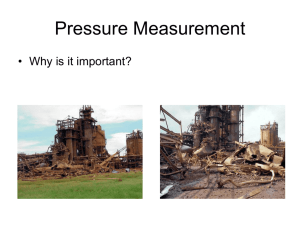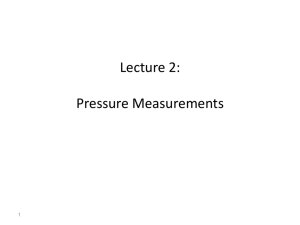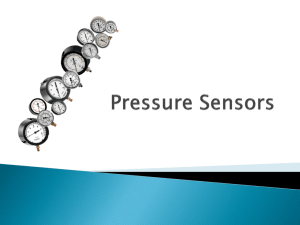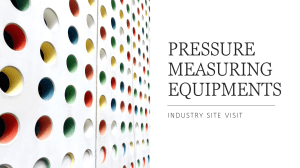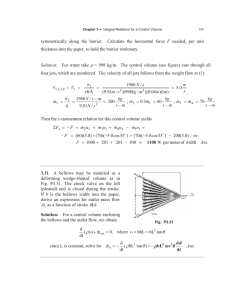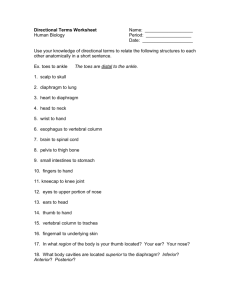Pressure Measurement Techniques: Bourdon, Diaphragm, Bellows
advertisement
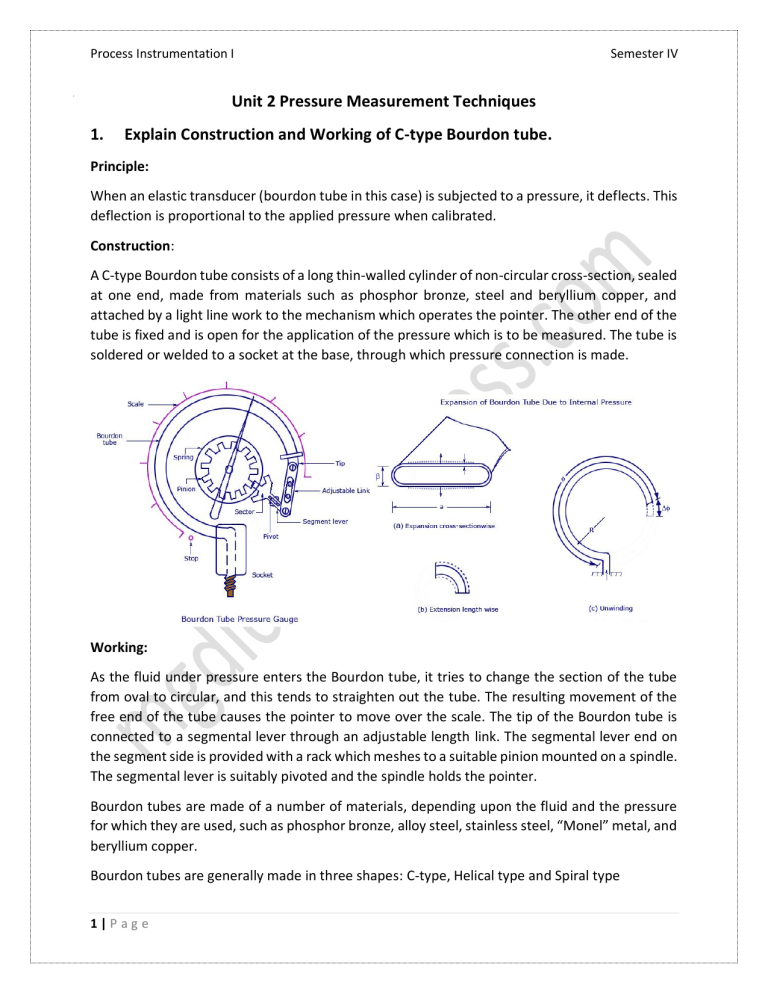
Process Instrumentation I Semester IV Unit 2 Pressure Measurement Techniques 1. Explain Construction and Working of C-type Bourdon tube. Principle: When an elastic transducer (bourdon tube in this case) is subjected to a pressure, it deflects. This deflection is proportional to the applied pressure when calibrated. Construction: A C-type Bourdon tube consists of a long thin-walled cylinder of non-circular cross-section, sealed at one end, made from materials such as phosphor bronze, steel and beryllium copper, and attached by a light line work to the mechanism which operates the pointer. The other end of the tube is fixed and is open for the application of the pressure which is to be measured. The tube is soldered or welded to a socket at the base, through which pressure connection is made. Working: As the fluid under pressure enters the Bourdon tube, it tries to change the section of the tube from oval to circular, and this tends to straighten out the tube. The resulting movement of the free end of the tube causes the pointer to move over the scale. The tip of the Bourdon tube is connected to a segmental lever through an adjustable length link. The segmental lever end on the segment side is provided with a rack which meshes to a suitable pinion mounted on a spindle. The segmental lever is suitably pivoted and the spindle holds the pointer. Bourdon tubes are made of a number of materials, depending upon the fluid and the pressure for which they are used, such as phosphor bronze, alloy steel, stainless steel, “Monel” metal, and beryllium copper. Bourdon tubes are generally made in three shapes: C-type, Helical type and Spiral type 1|P ag e Process Instrumentation I 2. Semester IV Which adjustments need to perform on bourdon tube? Explain each in brief. Multiplication adjustment: Because of the compound stresses developed in the Bordon tube, actual travel is nonlinear in nature. However, for a small travel of the tip, this can be considered to be linear and parallel to the axis of link. Small linear tip movement is matched with a rotational pointer movement. This is known as multiplication and can be adjusted by adjusting the length of the lever. Shorter lever gives larger rotation for same amount of the tip travel. Angularity: When the approximately linear motion of the tip is converted to a circular motion with the link lever and pinion attachment, a one to one correspondence between them may not occur and a distortion results. This is known as angularity. This can be minimized by adjusting the length of the link. 3. List advantages and disadvantages of Bourdon Tube. Advantages: 1. 2. 3. 4. 5. 6. These Bourdon tube pressure gauges give accurate results. Bourdon tube cost low. Bourdon tube are simple in construction. They can be modified to give electrical outputs. They are safe even for high pressure measurement. Accuracy is high especially at high pressures. Disadvantages: 1. 2. 3. 4. 5. 4. They respond slowly to changes in pressure They are subjected to hysteresis. They are sensitive to shocks and vibrations. Amplification is a must as the displacement of the free end of the bourdon tube is low. It cannot be used for precision measurement. Explain Construction and Working of metallic and nonmetallic (Slack) Diaphragm pressure transducer. A diaphragm pressure transducer is used for low pressure measurement. They are commercially available in two types – metallic and non-metallic. Metallic diaphragms are known to have good spring characteristics and non-metallic types have no elastic characteristics. Thus, non-metallic types are used rarely, and are usually opposed by a calibrated coil spring or any other elastic type gauge. The non-metallic types are also called slack diaphragm. 2|P ag e Process Instrumentation I Semester IV Non Metallic (Slack) Diaphragm Construction: It is made up of rubber or other flexible material. Making a diaphragm slack rather than tight allows it to move large distance in response to a small pressure. A pointer is attached with the diaphragm via linkage. Pressure is applied at the input and is indicated on the scale. Working The diagram of a diaphragm pressure gauge is shown below. Unknown pressure is applied to the input (P1) of the gauge which will exerts force on the slack diaphragm. When a force acts against a thin stretched diaphragm, it causes a deflection of the diaphragm with its center deflecting the most. This movement is transferred to the pointer mechanism via leaf spring as shown in figure. Figure 1 Non Metallic Diaphragm Non-metallic or slack diaphragms are used for measuring very small pressures. The commonly used materials for making the diaphragm are polythene, neoprene, animal membrane, silk, and synthetic materials. Due to their non-elastic characteristics, the device will have to be opposed with external springs for calibration and precise operation. The common range for pressure measurement varies between 50 Pa to 0.1 MPa. Metallic Diaphragm Construction: Since the elastic limit has to be maintained, the deflection of the diaphragm must be kept in a restricted manner. This can be done by cascading many diaphragm capsules as shown in the figure 2. A main capsule is designed by joining two diaphragms at the periphery. A pressure inlet line is provided at the central position. Working: 3|P ag e Figure 2 Metallic Diaphragm Process Instrumentation I Semester IV When the pressure enters the capsule, the deflection will be the sum of deflections of all the individual capsules. This will also deflect the lever connected to the diaphragm. Through pivot, this movement of lever is transferred to the pointer and scale mechanism. As shown in figure, corrugated diaphragms are also used instead of the conventional ones. 5. List advantages and disadvantages of Diaphragm pressure gauge. Advantages of Elastic diaphragm gauges: 1. 2. 3. 4. 5. Best advantage is they cost less They have a linear scale for a wide range They can withstand over pressure and hence they are safe to be used. No permanent zero shift. They can measure both absolute and gauge pressure, that is, differential pressure. Disadvantages of Elastic diaphragm gauges: 1. Shocks and vibrations affects their performance and hence they are to be protected. 2. When used for high pressure measurement, the diaphragm gets damaged. 3. These gauges are difficult to be repaired. 6. Explain Construction and Working of Bellows type pressure gauge. Like a diaphragm, bellows are also used for pressure measurement, and can be made of cascaded capsules. The basic way of manufacturing bellows is by fastening together many individual diaphragms. The bellows element, basically, is a one-piece expansible, collapsible and axially flexible member. It has many convolutions or fold. It can be manufactured form a single piece of thin metal. 4|P ag e Process Instrumentation I Semester IV Construction: A bellows gauge contains an elastic element that is a convoluted unit that expands and contracts axially with changes in pressure. Most bellows gauges are spring-loaded; that is, a spring opposes the bellows, thus preventing full expansion of the bellows. Limiting the expansion of the bellows in this way protects the bellows and prolongs its life. In a spring-loaded bellows element, the deflection is the result of the force acting on the bellows and the opposing force of the spring. The movement of bellows is transferred to a pointer though a linkage. Bellows can also be used to measure differential pressure as shown in figure. Here two different pressure are applied to the two different pressure connection. Scale and Pointer is attached with gauge movement linkage at the center of the force bar. The bellows are connected between the input pressure connection and force bar. Working: The pressure to be measured is applied to the outside or inside of the bellows. However, in practice, most bellows measuring devices have the pressure applied to the outside of the bellows (see fig). As the inlet pressure varies, the bellows will expand or contract. This will move the linkage assembly and pointer will shows the applied pressure on the scale. For differential pressure measurement using bellows, applied differential pressure will try to imbalance the force bar and accordingly this movement is transferred to scale via gauge movement and pointer. Like Bourdon-tube elements, the elastic elements in bellows gauges are made of brass, phosphor bronze, stainless steel, beryllium-copper, or other metal that is suitable for the intended purpose of the gauge. Although some bellows instruments can be designed for measuring pressures up to 800 psig, their primary application is in the measurement of low pressures or small pressure differentials. 7. List advantages and disadvantages of Bellows type pressure gauge. Advantages • • • • Bellow joints do not require access; i.e. They can be direct buried, however a telltale is recommended No maintenance is required. Low cost Can be used to measured differential pressure Disadvantages • • Bellows joints can fail catastrophically. No in place maintenance or repair can be performed - they must be replaced if damaged. 5|P ag e Process Instrumentation I • • • Require that the system to be shut down when a failure occurs. Smaller pressure range of application. Temperature compensation needed. 6|P ag e Semester IV
